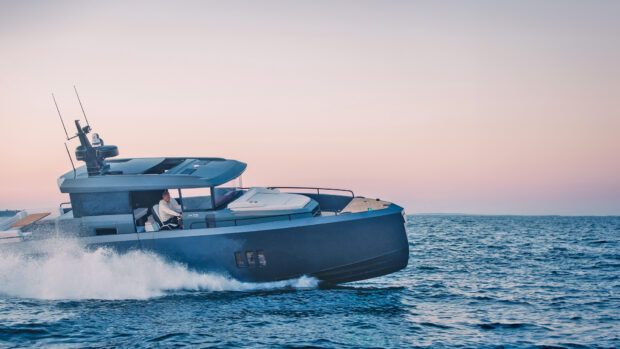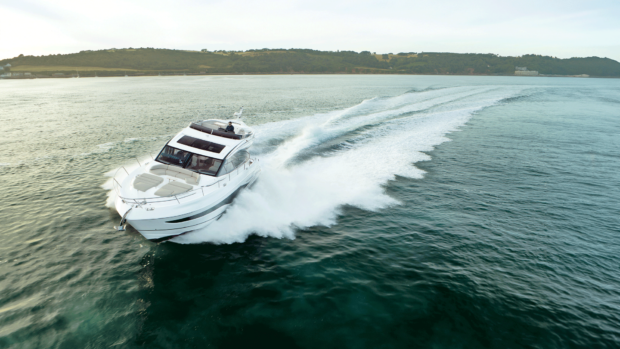In the racy flower power years, the Huntsman 28 was clocking up fast Speeds and a sexy image of powerboating.
In the racy flower power years, the Huntsman 28 was clocking up fast Speeds and a sexy image of powerboating. Thanks to their innovative build, many of these unfussy boats have survived, retaining their good looks and agility despite their age. Tom Willis reports.
To the sports editor of a national newspaper, modern offshore powerboat racing seems to be exceptionally irrelevant. One of the main reasons for the decline of the sport in recent years is the lack of media coverage both in the national press and on television. No coverage means no sponsors.
But this wasn’t always the case. Thirty five years ago, the Ford Motor Company felt powerboating was interesting enough to field a four-boat offshore racing team, both as a promotional exercise and as a test-bed for engine development. The boat they chose was a Fairey Huntsman 28.
First shown at the 1961 London Boat Show, the Huntsman was an enlarged version of Fairey’s 23ft (7m) Huntress. Both boats were named after American naval architect Ray Hunt, who had designed the then-innovative deep-vee hull they share.
Fast hard-chine boats of that period tended to have a deadrise of 5° at the transom, rising to about 15° amidships, but Hunt’s design increased transom deadrise to 20°.
This meant that the whole length of the bottom was immersed, even at high Speeds, reducing slamming and making for a much more comfortable ride.
Although the hull was essentially Hunt’s, the Huntsman itself was the brainchild of Alan Burnard, the chief designer at Fairey Marine.
Fairey’s wartime experience of building aircraft had given the company a major advantage in what was, by the standards of the time, high-tech marine construction, and the Huntsman milked the technology for all it was worth. The wisdom of Ford’s choice soon became apparent, with a string of successes in the Cowes-Torquay competition and other races.
The Huntsman was innovative in other ways. Most significantly, it was built using Fairey’s own hot-moulded wooden construction system. This involved laying thin strips of wood veneer diagonally over a male plug, with each successive lamination six on the topsides, seven on the bottom glued and stapled to the one beneath.
The hull was ‘bagged’ and air drawn out of the bag with a vacuum pump so that the veneers were compressed, squeezing the glue into the wood itself. It was then cured in a low-temperature oven using steam heat at 100°C.
The result was a much lighter, stronger hull than could be built in GRP at that time. The original engines were a pair of 86hp Parsons Barracuda diesels. When MBY tested it in 1961, this installation, modest by today’s standards, could nevertheless, push the boat up to 21.5 knots with six people on board and full tanks.
As improving engine technology increased engine power-to-weight ratios, so Performance climbed. Subsequent Huntsmen were fitted with 135hp turbocharged Perkins T6.354s or one of a wide variety of other engines, many based on Fords.
It is interesting to note that when first built, the Huntsman was available with a pair of 215hp Dearborn Interceptors (courtesy of the Ford connection), which gave a maximum Speed of around 26 knots.
A Huntsman re-engined today with a pair of modern turbocharged 225hp Sabres could be expected to achieve Speeds in the upper 30s.
As a cruiser, the Huntsman shows its age. There are few frills on the standard boat: accommodation consists of two or four berths, a basic galley and a toilet compartment. There was space left in the galley for a fridge, which was available as an optional extra.
Initially, the Huntsman was a two-berth cruiser, although many later models were fitted with an extra pair of berths in the forecabin. Other variations on the theme included a single-engined 26ft (7.9m) Huntsman, a 31-footer and a few petrol-engined versions. Racing cruisers, stripped to save weight, have more basic accommodation.
Buying second-hand, be prepared for a shock when you see the survey. The Huntsman remained in production from 1960 to 1972, which means that all are more than 25 years old, some over 35. If the boat you are considering hasn’t been restored, there may be a lot of work to do.
Although the method of construction ensured maximum protection of the agba (mahogany) veneers, the timber is especially vulnerable to fresh water permeating the endgrain.
Frames and stringers, where fitted, may have cracked, especially if the boat has been used for racing. Equipment ranging from cookers to steering may well need replacing, either because of basic wear and tear, or because there are much better modern alternatives to the original specification.
Having said that, the Huntsman 28 is one of the greatest motor cruisers of all time. It looks right; it handles superbly. Restored and refitted, it will continue for another quarter century. No matter how much you spend on the restoration, it will still be only half the price of a modern equivalent.








